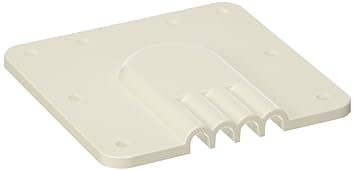- Good Sam Community
- Everything RV
- Technical Issues
- Re: drilling roof for solar ...
- Subscribe to RSS Feed
- Mark Topic as New
- Mark Topic as Read
- Float this Topic for Current User
- Bookmark
- Subscribe
- Mute
- Printer Friendly Page
drilling roof for solar ...
- Mark as New
- Bookmark
- Subscribe
- Mute
- Subscribe to RSS Feed
- Permalink
- Report Inappropriate Content
Apr-11-2017 05:51 AM
Our fridge vents through the side wall so I don't have a roof vent to use. Obviously I have holding tank vents but I don't know where they are in relation to where the panels will be vs where the charge controller will be.
My question is ... it seems that everyone is afraid of drilling through the roof to run the wires from the combiner box to the charge controller. I understand water leaks are a campers enemy, but with the sealing tech out there, if done correctly, is this really an issue?
Am I missing something?
'13 GMC Serria D/A, CC, 4x4
'16 Forest River Vengeance 25V
- Mark as New
- Bookmark
- Subscribe
- Mute
- Subscribe to RSS Feed
- Permalink
- Report Inappropriate Content
Apr-11-2017 03:18 PM
Colo Native wrote:
Heres what I did. Lots of Dicor
I used a couple of those plastic junction boxes. I found that in a couple of years the sun warps the cover and destroys the rubber gasket.
Try one of these:

2010 - 2021 Full Timer (41’ 2001 Newmar Mountain Aire 4095 DP - Cummins)
2021 - ??? Part Timer (31’ 2001 National RV Sea View 8311 - Ford)
www.rvSeniorMoments.com
DISH TV for RVs
- Mark as New
- Bookmark
- Subscribe
- Mute
- Subscribe to RSS Feed
- Permalink
- Report Inappropriate Content
Apr-11-2017 11:38 AM
Purchase a through-deck kit from a Marine store or chandlers. UV proof plastic. Decades lifespan. All work done from above. No sandwich both-sides nightmares. Capable of handling swamping.
I've done a dozen and they are incredibly forgiving - easy to install and boy do they ever last. Quicksilver has had one since 1988.
For sure West Marine, has them and they are listed in their online catalog.
- Mark as New
- Bookmark
- Subscribe
- Mute
- Subscribe to RSS Feed
- Permalink
- Report Inappropriate Content
Apr-11-2017 10:59 AM
- Mark as New
- Bookmark
- Subscribe
- Mute
- Subscribe to RSS Feed
- Permalink
- Report Inappropriate Content
Apr-11-2017 09:22 AM
'13 GMC Serria D/A, CC, 4x4
'16 Forest River Vengeance 25V
- Mark as New
- Bookmark
- Subscribe
- Mute
- Subscribe to RSS Feed
- Permalink
- Report Inappropriate Content
Apr-11-2017 08:37 AM
I used a 3/4" hole saw INSIDE on the ceiling being careful to just cut the ceiling. I then had visibility and probing access to the roof. Checked for wires etc and then drilled up through the roof with a small drill - note you may need a longer drill. After the wiring was completed the ceiling hole was sealed. Removing ceiling fixtures like lights, speakers, etc can also provide insight as to what to expect.
750 Watts Solar Morningstar MPPT 60 Controller
2014 Grand Cherokee Overland
Bob
- Mark as New
- Bookmark
- Subscribe
- Mute
- Subscribe to RSS Feed
- Permalink
- Report Inappropriate Content
Apr-11-2017 08:15 AM

A hole saw allows you to drill slowly and watch where you're going -- and avoid hitting wires, etc.
2010 - 2021 Full Timer (41’ 2001 Newmar Mountain Aire 4095 DP - Cummins)
2021 - ??? Part Timer (31’ 2001 National RV Sea View 8311 - Ford)
www.rvSeniorMoments.com
DISH TV for RVs
- Mark as New
- Bookmark
- Subscribe
- Mute
- Subscribe to RSS Feed
- Permalink
- Report Inappropriate Content
Apr-11-2017 08:01 AM
My main concern was the shortest distance and no visible wires inside. I used a ceiling to floor cabinet. Removed the cabinet inside side panels (brads and glue - came right out) ran the wires and reattached the panels with screws for any future access.
750 Watts Solar Morningstar MPPT 60 Controller
2014 Grand Cherokee Overland
Bob
- Mark as New
- Bookmark
- Subscribe
- Mute
- Subscribe to RSS Feed
- Permalink
- Report Inappropriate Content
Apr-11-2017 07:49 AM
2004 32' Carriage 5th wheel. 860 watts of solar MPPT, two SOK 206 ah LiFePO4 batteries. Samlex 2,000 watt Pure Sine Wave Inverter.
- Mark as New
- Bookmark
- Subscribe
- Mute
- Subscribe to RSS Feed
- Permalink
- Report Inappropriate Content
Apr-11-2017 07:41 AM

pushed by a 2011 Fusion Hybrid or 2020 Escape Hybrid
Retired DFD
- Mark as New
- Bookmark
- Subscribe
- Mute
- Subscribe to RSS Feed
- Permalink
- Report Inappropriate Content
Apr-11-2017 06:48 AM
Of course you have to hope you don't hit some other wiring such as the feed for the a/c but with some looking around you can usually gleem how they ran the wires.
2013 Adventurer 89RB
- Mark as New
- Bookmark
- Subscribe
- Mute
- Subscribe to RSS Feed
- Permalink
- Report Inappropriate Content
Apr-11-2017 06:25 AM
For those that think a few Dicored holes is going to ruin resale value, well, there is no hope for that kind of mentality anyway !
'01 31' Rexall Vision, Generac 5.5k, 1000 watt Honda, PD 9245 conv, 300 watts Solar, 150 watt inv, 2 Cos 6v batts, ammeters, led voltmeters all over the place, KD/sat, 2 Oly Cat heaters w/ ox, and towing a 2012 Liberty, Lowe bass boat, or a Kawi Mule.
- Mark as New
- Bookmark
- Subscribe
- Mute
- Subscribe to RSS Feed
- Permalink
- Report Inappropriate Content
Apr-11-2017 06:00 AM





